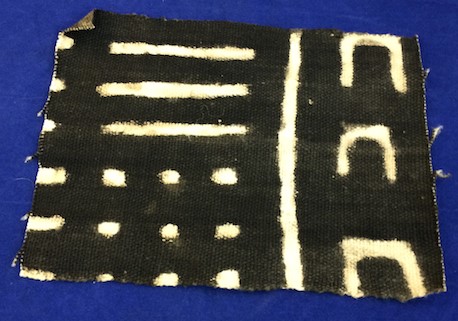These seven maskettes are individually hand-made works in ebony wood, but they represent a type of carving that is mass-produced in Senegal for the tourist-trade. Such sets of seven maskettes are marketed to the tourist community as wall hangings that represent the seven days of the week. The material, color, and size of the masks unites them as a group, and the masks that … [Read more...] about Seven Ebony Maskettes: Researched by Codee Ratliff
Batik textiles originated in Indonesia, but they were introduced into Africa sometime before the 20th century, where they were embraced and have become very popular. The batik process involves painting wax designs onto a fabric and then submerging it into a dye bath. The process may be repeated for additional colors and to create complex layers of designs. Cracks in the wax … [Read more...] about Batik Shirt with Orange Yin-Yang Symbols: Researched by Hannah Harmon
Kuba cut-pile cloth, also known Kasai velvet or Shoowa velvet, is an elaborate, labor-intensive cloth that is highly valued among the Kuba as well as being a popular collector’s item outside of Africa. After men weave the basic background cloth of softened raffia fibers, the cloths are delivered to the female master artisans. These women embroider outlines onto the cloth, … [Read more...] about Tan Cut-Pile Cloth with Hexagon Design: Researched by Hannah Harmon
Like Senufo Korhogo cloth, Bogolanfini cloth is dyed with a type of iron-rich mud. Bogolanfini cloth differs from other mud cloths, however, in that the mud dyes are not only especially rich in minerals, but also fermented, and they therefore produce an especially deep brownish-black color. Bogolanfini cloth also differs in being made using a negative process. The designs are … [Read more...] about Bogolanfini Mud Cloth with Lines, Dots, and U shapes: Researched by Hannah Harmon
This cloth figure represents a 20th-century Ghanaian woman doing chores, sweeping up the mess that is in front of her. The most interesting aspect of this figure, however, is that she wears a dress and head covering of fabric printed to represent the famous Asante cloth known as Kente. Like the Korhogo cloth also in this exhibit, Kente cloth is one of the few textiles in … [Read more...] about Figure of a Sweeping Woman wearing Kente Cloth: Researched by Hannah Harmon





